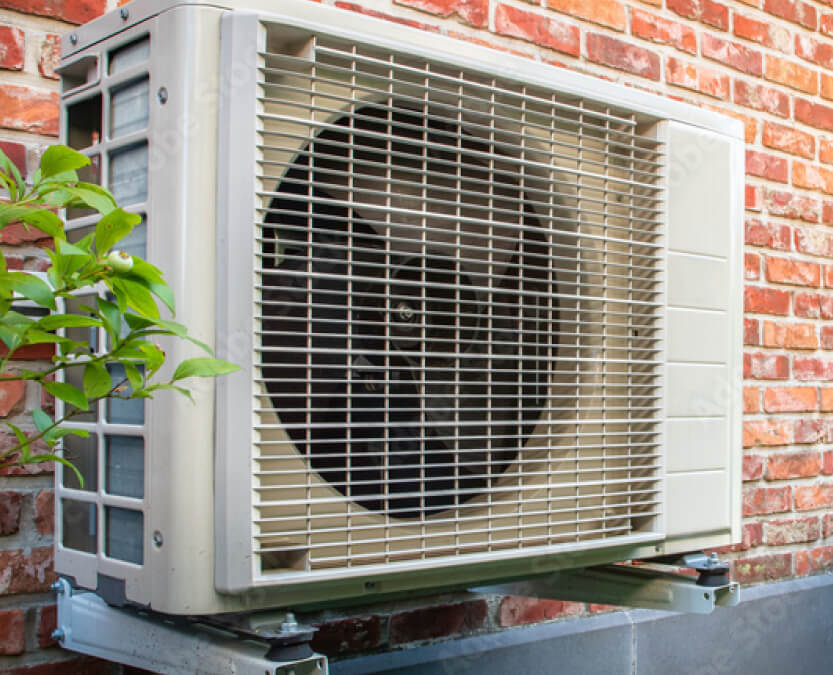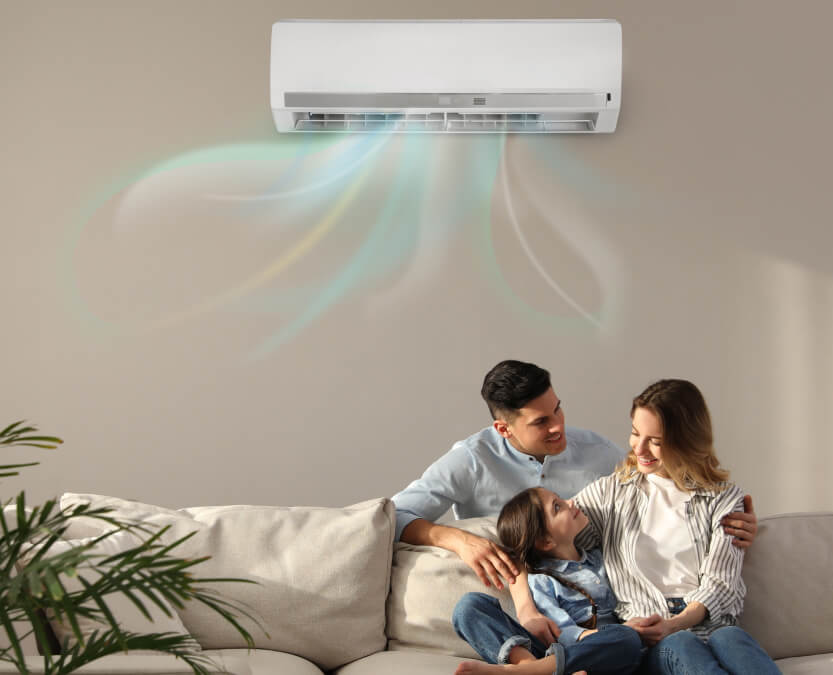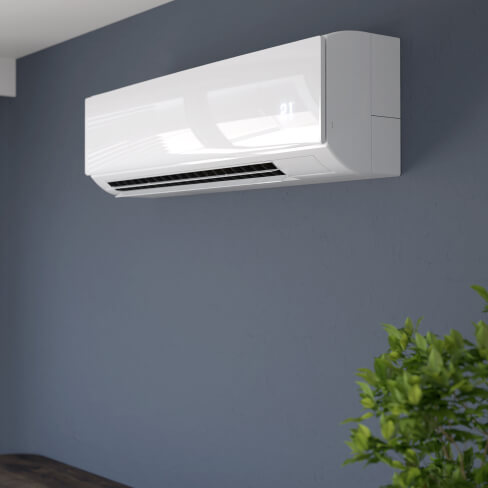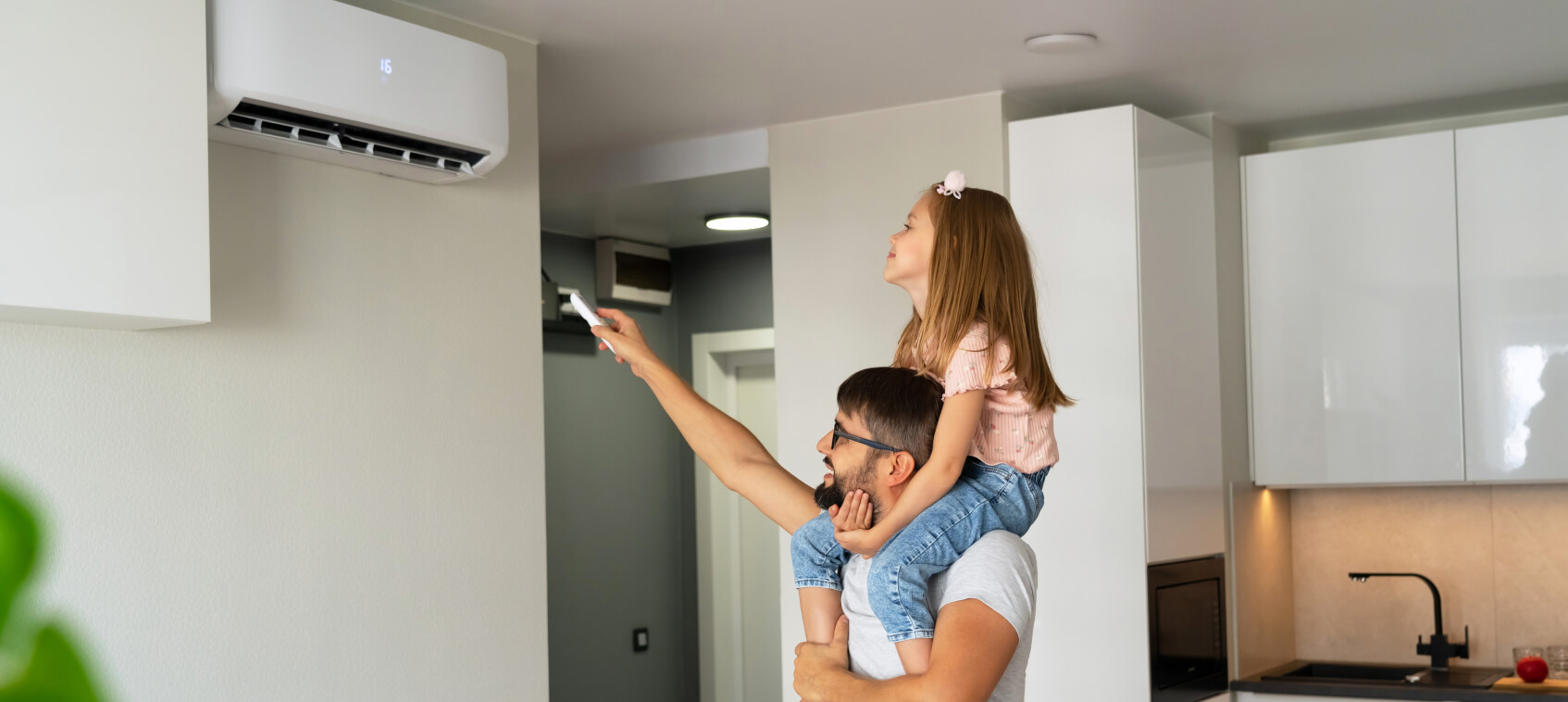Ductless Mini-Split
Heat Pumps
Efficient Heating & Cooling for Greater Boston Area

Heat Pumps, Mini-Splits, Ductless… What does all that mean?
A ductless mini-split heat pump is a type of heating and cooling system that does not require ductwork to distribute air. It consists of an indoor air-handling unit and an outdoor compressor unit, connected by refrigerant lines. These systems are known for their efficiency, flexibility, and ability to provide zoned temperature control.
Key Components of a Ductless Heat Pump
Outdoor Unit (Compressor)
Placed outside the building, this component houses the compressor and condenser, which are responsible for transferring heat to or from the refrigerant.
Indoor Unit (Air Handler)
Mounted on the wall, ceiling, or floor, these components contain the evaporator coil and blower fan to distribute conditioned air into the room.
Refrigerant Lines
These are are thin pipes that connect the indoor and outdoor units, circulating refrigerant between them. Typically run through a small hole drilled in the wall, making installation less invasive than ducted systems.

Heat Pump
This is the part of a mini-split system which lives outside. There are ways to jazz this up, but it looks like a small air conditioning unit until you get up close.
The whole system together is called a mini split because it is more compact than the traditional split system you might already have with air conditioning and heating.

Air Handler
This is the part people usually think is the mini-split, but mini-split refers to the whole system, including the heat pump. The air handler is the indoor component which delivers the warm and cool air, with a remote control!
How It Works
Cooling Mode
In cooling mode, the system extracts heat from inside the home and transfers it outside, cooling the indoor air.
Play Video
Heating Mode
In heating mode, it reverses the process, absorbing heat from the outside air (even in colder temperatures) and bringing it indoors. This is possible because heat pumps can extract thermal energy even from cold air, making them highly efficient.
Play Video
Why Everyone is Talking About Heat Pumps
Ductless mini-split heat pumps are popular because they provide efficient, cost-effective heating and cooling, flexible installation options, and improved indoor air quality. Their ability to deliver zoned comfort, combined with energy savings and eco-friendliness, makes them an appealing choice for homeowners and businesses alike.
Energy Efficiency
Why It’s Important:
Heat pumps are extremely energy efficient compared to traditional HVAC systems. Energy Star certified mini-splits have been found to use 60% less energy than standard radiators, 40% less energy than window air conditioners, and up to 40% less energy than baseboard heating systems. In traditional ducted systems, up to 30% of energy usage can be lost through leaky ductwork.
Benefit:
Lower energy consumption results in reduced utility bills, making them cost-effective in the long run.
Go deeper:
Zoned Comfort Control
Why It’s Important:
Ductless systems allow for individual room temperature control, enabling users to heat or cool only the rooms they use, rather than the entire house. This zoning capability offers customized comfort and prevents energy waste.
Benefit:
Personalized temperature control in different rooms or "zones" enhances comfort and reduces energy usage.
No Ductwork Required
Why It’s Important:
Traditional HVAC systems require ductwork, which can be costly and difficult to install in older homes or buildings without existing ducts. Ductwork can also lead to energy losses (up to 30%) through leaks and poor insulation.
Benefit:
Ductless systems are easier and cheaper to install, especially in retrofit situations. They also avoid the inefficiencies of ductwork, making them more energy-efficie.
Heating and Cooling in One System
Why It’s Important:
Mini-split heat pumps can both heat and cool, eliminating the need for separate systems for winter and summer. This versatility makes them a year-round solution.
Benefit:
Saves money and space by combining heating and cooling functions in one efficient system.
Government Incentives
Why It’s Important:
Many governments and utility companies offer rebates or incentives for installing energy-efficient systems like ductless mini-split heat pumps. This helps offset the upfront costs.
Benefit:
Reduces the initial cost of purchase and installation, making them more affordable.
Flexible Design and Aesthetics
Why It’s Important:
Ductless mini-split heat pumps come in various styles, including wall-mounted, ceiling cassette, and floor-mounted units, allowing homeowners to choose an option that blends with their interior design.
Benefit:
Provides design flexibility, allowing for discreet installations in different areas of the home.
Environmentally Friendly
Why It’s Important:
Mini-split heat pumps use less energy to operate, reducing their carbon footprint. In addition, many systems now use refrigerants that have a lower global warming potential (GWP).
Benefit:
A more eco-friendly heating and cooling option that supports sustainability efforts
Easy Installation
Why It’s Important:
Unlike central air systems that require extensive ductwork installation, ductless mini-splits require only a small hole in the wall for the refrigerant lines, making installation much faster and less invasive.
Benefit:
Reduces labor costs and time for installation, particularly in older buildings or homes without existing ducts.
Trusted, licensed Mass Save Installer Serving The Greater Boston Area


Heat Pumps and Mini-Splits for Homes
The compact nature of mini-split systems means they can be installed in houses, townhouses, row houses, and condos of (almost) any size and shape — especially older homes and tiny homes. Some questions we field from our Boston-area customers like you include:
Yes! In fact this is the most common use for installing heat pumps and mini-splits. Why? Well, a central air conditioning system is already a split system, but heat pumps are much more energy efficient than traditional air conditioners because instead of actively cooling the outdoor air, they passively remove heat from the indoor air. Learn more: replacing central AC with mini-splits
Yes! This is the heat pump mini-split secret weapon! Because heat pumps work by moving heat from one space to another, and because heat is always present (even when it’s cold outside), they can extract heat from outdoors and bring it indoors all winter long. Learn more: replacing a furnace with mini-splits
Think of a heat pump like a super-efficient mover, taking heat from outside (where it's not needed) and bringing it inside (where it is) for warmth in winter. In summer, it reverses the process, pulling heat out of your home to keep you cool. Unlike heaters and air conditioners that generate heat, heat pumps simply move it around, saving you energy. For more information: What are heat pumps? and Are heat pumps efficient in Massachusetts?
Instead of bulky ductwork, which is how conditioned air moves around in a traditional split system, compact refrigerant tubing moves conditioned air around a home which uses a ductless mini-split system for climate control.
Great question! There are some natural places in homes where they work really well, like converted attics, garages, and sunrooms. Bedrooms, dining rooms, and kitchens also make ideal places for fine-tuned temperatures in your home. For more information: Where can I put an air handler?
No, probably not. Our licensed technicians will help decide on the right mix of air handlers for your home, based on its layout, its size, and your family’s heating and air conditioning needs.
What Types of Mini-Splits Are There?
Many well known brands make heat pumps and air handlers for mini-split systems. Here are the three main types of mini-splits, illustrated by examples from recent Home Mechanics installations for clients in the Boston area:

Wall-mounted
Easy to install and maintain, this style offers excellent energy efficiency and a compact design that fits well in most spaces.

Floor-mounted
Easy to access for cleaning and maintenance, this model is ideal for rooms with low ceilings or sloped walls like attics.

Ceiling Cassette
More aesthetically pleasing with the lower profile, this model provides better airflow distribution, making int ideal for bigger or open-plan spaces.

Most Popular Overall
Wall-Mounted Mini-Splits tend to dominate the market due to their flexibility, affordability, and ease of installation in residential settings.

We serve most towns and cities in the Greater Boston area and Merrimack Valley
and would love to come out and show you how this home upgrade will work for your family.
Precise Home Comfort
In addition to their financial savings, Mini-split systems are known for their flexibility and comfort. Here are just a few of the ways ductless mini-split heat pumps are an excellent choice for providing the perfect indoor climate.
Zoned Heating & Cooling
Mini-splits offer the ability to control the temperature in individual rooms or zones. This means you can set different temperatures in different parts of your home, providing personalized comfort in every room.
Quiet Operation
Mini-split systems are typically much quieter than traditional HVAC systems, especially because the compressor (the noisier part) is located outside the home. The indoor units are designed to run almost silently, making them perfect for bedrooms and quiet spaces.
Precise Temperature Control
Mini-splits come with smart thermostats and remote controls that allow for precise adjustments, helping to maintain a consistent and comfortable indoor environment.
Air Filtration
Mini-splits include built-in air filtration systems that can remove dust, allergens, and other particles, contributing to better indoor air quality and comfort for those with allergies or respiratory issues.
Dehumidification
Besides heating and cooling, mini-split systems can also dehumidify the air, which is especially beneficial in humid climates. Removing excess moisture from the air makes the indoor environment more comfortable.
Smart Features
Mini-splits can be connected to your home network allowing you to control the system via a smartphone app or integrate it with home automation systems for convenient remote control.
